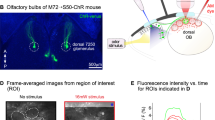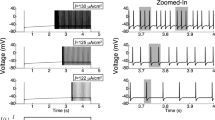Abstract
A physiological simulation of 2.5% of the input and inhibitory neurons and 25% of the primary mitral/tufted cells in a single mammalian olfactory bulb glomerulus was constructed. This physiological simulation used the integrate-and-fire paradigm with realistic activation curves and synaptic delays. The dendritic integration incorporated non-linear interactive effects of individual cell excitatory and inhibitory post-synaptic potentials (PSPs) from both axodendritic and dendrodendritic synaptic contacts. Refractory periods for granule-cell inhibition of mitral/tufted cell activity lead to relatively fixed-frequency rhythmic activity in the glomerulus, independent of the input frequency from the olfactory nerve. Though the frequency of mitral/ tufted cell firing in bulb was approximately independent of input frequency, the number of cells active in the glomerulus was a roughly-linear function of input frequency to the glomerulus, indicating the mechanism's ability to function as a frequency-to-spatial encoder.
Similar content being viewed by others
References
Adrian ED (1950) The electrical activity of the mammalian olfactory bulb. Electroencephalogr Clin Neurophysiol 2:377–388
Allison AC (1953) The morphology of the olfactory system in the vertibrates. Biol Rev 28:195–244
Ambros-Ingerson J, Granger R, Lynch G (1990) Simulation of paleocortex performs hierarchical clustering. Science 247:1344–1348
Antón PS (1991) Simulations of information processing, control, and plasticity effects in the olfactory bulb. Ph. D. Thesis, University of California, Irvine
Castellucci VF (1985) The chemical senses: taste and smell. In: Kandel ER, Schwartz JH (eds) Principles of neural science, 2nd edn. Elsevier, New York Amsterdam Oxford, pp 409–425
DeVries H, Stuiver M (1961) The absolute sensitivity of the human sense of smell. In: Rosenblith WA (ed) Sensory communication. MIT Press, Cambridge
Eisenberg J, Freeman WJ, Burke B (1989) Hardware architecture of a neural network model simulating pattern recognition by the olfactory bulb. Neural Networks 2:315–325
Freeman WJ (1987) Simulations of chaotic EEG patterns with a dynamic model of the olfactory system. Biol Cybern 56:139–150
Freeman WJ, Schneider W (1982) Changes in spatial patterns of rabbit olfactory EEG with conditioning to odors. Psychophysiology 19:44–56
Getchell TV (1986) Functional properties of vertebrate olfactory receptor neurons. Physiol Rev 66:772–818
Getchell TV, Shepherd GM (1978) Responses of olfactory receptor cells to step pulses of odour at different concentrations in the salamander. J Physiol 282:521–540
Granger R, Ambros-Ingerson J, Staubli U, Lynch G (1990a) Memorial operation of multiple, interacting simulated brain structures. In: Gluck M, Rummelhart D (eds) Neuroscience and connectionist theory. Lawrence Erlbaum Associates, Hillsdale, pp 95–129
Granger R, Ambros-Ingerson J, Antón P, Lynch G (1990b) Unsupervised perceptual learning: a paleocortical model. In: Hanson SJ, Olson CR (eds) Connectionist modeling and brain function: the developing interface. MIT Press, Cambridge, pp 105–131
Jack JJB, Noble D, Tsien RW (1975) Electric current flow in excitable cells. Clarendon Press, Oxford
Koch C, Poggio T (1987) Biophysics of computation: neurons, synapses, and membranes. In: Edelman GM, Gall WE, Cowan WM (eds) Synaptic function. Wiley, New York, pp 637–697
Kuffler SW, Nicholls JG, Martin AR (1984) From neuron to brain. Sinauer, Sunderland
Li Z, Hopfield JJ (1989a) Modeling the olfactory bulb and its neural oscillatory processings. Biol Cybern 61:379–392
Li Z, Hopfield JJ (1989b) Modeling the olfactory bulb—coupled nonlinear oscillators. In: Touretzky DS (ed) Advances in neural information processing systems I. Morgan Kaufmann, San Mateo, pp 402–409
Macrides F, Schneider SP (1982) Laminar organization of mitral and tufted cells in the main olfactory bulb of the adult hamster. J Comp Neurol 208:419–430
Mori K (1987) Membrane and synaptic properties of identified neurons in the olfactory bulb. Prog Neurobiol 29:275–320
Mori K, Takagi SF (1978a) An intracellular study of dendrodendritic inhibitory synapses on mitral cells in the rabbit olfactory bulb. J Physiol 279:569–588
Mori K, Takagi SF (1978b) Activation and inhibition of olfactory bulb neurons by anterior commissure volleys in the rabbit. J Physiol 279:589–604
Mori K, Kishi K, Ojima H (1983) Distribution of dendrites of mitral, displaced mitral, tufted, and granule cells in the rabbit olfactory bulb. J Comp Neurol 219:339–355
Nowycky MC, Mori K, Shepherd GM (1981) Blockage of synaptic inhibition reveals long-lasting synaptic excitation in isolated turtle olfactory bulb. J Neurophysiol 46:649–658
Onoda N, Mori K (1980) Depth distribution of temporal firing patterns in olfactory bulb related to air-intake cycles. J Neurophysiol 44:29–39
Orona E, Rainer EC, Scott JW (1984) Dendritic and axonal organization of mitral and tufted cells in the rat olfactory bulb. J Comp Neurol 226:346–356
Rall W (1962) Theory of physiological properties of dendrites. Ann NY Acad Sci 96:1071–1092
Rall W, Shepherd GM, Reese TS, Brightman MW (1966) Dendrodendritic synaptic pathway for inhibition in the olfactory bulb. Exp Neurol 14:44–56
Roman FU, Staubli U, Lynch G (1987) Evidence for synaptic potentiation in a cortical network during learning. Brain Res 418:221–226
Schneider SP, Scott JW (1983) Orthodromic response properties of rat olfactory bulb mitral and tufted cells correlate with their projection patterns. J Neurophysiol 50:358–378
Schoenfeld TA, Macrides F (1984) Topographical organization of connections between the main olfactory bulb and pars externa of the anterior olfactory nucleus in the hamster. J Comp Neurol 227:121–135
Shepherd GM (1972) Synaptic organization of the mammalian olfactory bulb. Physiol Rev 52:864–917
Shepherd GM (1979) The synaptic organization of the brain, 2nd edn. Oxford University Press, New York Oxford
Tuckwell HC (1988) Introduction to theoretical neurobiology, vol 1. Cambridge University Press, Cambridge
Vodyanoy V (1988) Molecular sensor based on olfactory transduction. In: Hong FT (ed) Molecular electronics: biosensors and biocomputers. Plenum Press, New York London, pp 317–28
Wellis DP, Scott JW (1990) Intracellular responses of identified rat olfactory bulb interneurons to electrical and odor stimulation. J Neurophysiol 64:932–947
Author information
Authors and Affiliations
Rights and permissions
About this article
Cite this article
Antón, P.S., Lynch, G. & Granger, R. Computation of frequency-to-spatial transform by olfactory bulb glomeruli. Biol. Cybern. 65, 407–414 (1991). https://doi.org/10.1007/BF00216975
Received:
Accepted:
Issue Date:
DOI: https://doi.org/10.1007/BF00216975




